#South African Angelenos
Text
Nobody Drives in LA -- The Ostrich Farm Railway
THE OSTRICH FARM RAILWAY
Detail of Map of the City of Los Angeles, 1887, depicting the route of the Ostrich Farm Railway
[Note: This essay was written for and originally appeared in the Silver Lake Neighborhood Council newsletter]
Today Silver Lake is, by most accounts, moderately well served by mass transit. The website, Walk Score, assigns Silver Lake a transit score of 54 out of a possible…
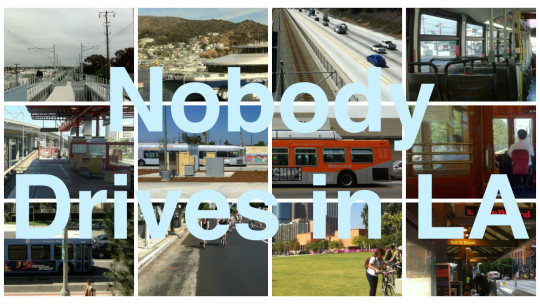
View On WordPress
#Echo Park#Griffith J. Griffith#Griffith Park#Kenilworth Ostrich Farm#Los Angeles and Ostrich Farm Railroad#Nobody Drives in LA#Ostrich Farm Railway#Ostriches#silver lake#Silver Lake Neighrbohood Council#South African Angelenos#Sunset Boulevard#the Los Angeles Ostrich Farm and Zoological Garden
0 notes
Text
Press Release Packages

Publication
Price
Genre
Hood Critic
$300
Music
LA Collide
$300
News
NY Times Mag
$300
News
Flaunt Weekly
$450
News
West Hollywood Weekly
$600
Lifestyle
The Beverly Weekly
$600
Lifestyle
The Influential
$600
Lifestyle
Elite Luxury News
$600
Luxury
Elite Music News
$600
Music
KAZI Magazine
$600
Music
Broke & Chic
$600
News
Huff Mag
$600
News
CEO Weekly
$600
News
SF Post
$600
News
Entertainment Monthly News
$600
News
Famous Times
$600
News
Influencer Daily
$600
News
Miami Wire
$600
News
US Insider
$600
News
US Reporter
$600
News
Voyage New York
$600
News
NY Wire
$600
News
Elite Property News
$600
Real Estate
Market Business Now
$750
Business
Fox Interviewer
$750
News
Music Observer
$750
News
LA Wire
$750
News
Kivo Daily
$750
News
Zycrypto
$900
Crypto
Block Telegraph
$900
Crypto
Hype Magazine
$900
Lifestlye
Cultr Magazine
$900
Music
Now Hip Hop
$900
Music
LA Guest List
$900
News
Chiang Rai Times
$900
News
Los Angeles Tribune
$900
News
Now Entertainment
$900
News
Real Estate Today
$900
Real Estate
IB Times (AP)
$1,200
Business
EDM Sauce
$1,200
Music
We Rave You
$1,200
Music
Music Times
$1,200
Music
Hype Fresh
$1,200
Music
Music News
$1,200
Music
Magnetic Mag
$1,200
Music
EDM Tunes
$1,200
Music
VC Post
$1,200
News/Finance
Latin Post
$1,200
News
CelebMix
$1,500
Lifestyle
Your EDM
$1,500
Music
Billboard Argentina
$1,500
Music
Rap Reviews
$1,500
Music
AllHipHop
$1,500
Music
Irvine Weekly
$1,500
News
Bust Magazine
$1,500
News
Cryptopolitan
$1,800
Crypto
The Game Haus
$1,800
Gaming
Super Crypto News
$1,800
Crypto
Fashion Week Daily
$1,800
Fashion
EarMilk
$1,800
Music
Neon Music
$1,800
Music
Digital Music News
$1,800
Music
Khaleej Times
$1,800
News
Good Men Project
$1,800
News
CoinPedia
$2,100
Crypto
Hip Hop DX Mention
$2,100
Music
Digital Journal (Editorial)
$2,100
News
Notion Online
$2,100
News
Crypto News
$2,400
Crypto
Sheen Magazine
$2,400
Lifestyle
Unfinished Man
$2,400
Lifestyle
Lyrical Lemonade
$2,400
Music
Live Mint
$2,400
News/Finance
Contrast Magazine
$2,400
News
Geek Extreme
$2,400
Tech
Grit Daily
$2,700
News
Nob Hill Gazzette
$2,700
News
SF Weekly
$2,700
News
SF Examiner
$2,700
News
The South African
$2,700
News
HackerNoon Full Feature
$2,700
Tech/Crypto
Tech Times
$2,700
Tech/Business
FXStreet
$3,000
Crypto
U.Today
$3,000
Crypto
Bitcoinist
$3,000
Crypto
NewsBTC
$3,000
Crypto
Female First
$3,000
News
Village Voice
$3,000
News
Business Insider Africa
$3,000
News
Swagger Magazine
$3,000
News
Womens Golf Journal
$3,000
News
Front Page Detectives
$3,000
News
Morning Honey
$3,000
News
The Royal Observer
$3,000
News
Times of Malta
$3,000
News
Miami New Times
$3,000
News
West Word
$3,000
News
Dallas Observer
$3,000
News
Phoenix New Times
$3,000
News
Mensbook
$3,150
Lifestlye
San Francisco Magazine
$3,150
Lifestlye
Vegas Magazine
$3,150
Lifestlye
LA Confidential
$3,150
Lifestlye
Gotham Magazine
$3,150
Lifestlye
Jezebel Magazine
$3,150
Luxury
Miami Magazine
$3,150
Luxury
Hamptons Magazine
$3,150
Luxury
Aspen Magazine
$3,150
Luxury
Modern Luxury Silicon Valley
$3,150
News
Dallas Magazine
$3,150
News
Modern Luxury Angeleno
$3,150
News
Aspen Peak Magazine
$3,150
News
Manhattan Magazine
$3,150
News
San Diego Magazine
$3,150
News
CoinSpeaker
$3,300
Crypto
Fast Company Africa
$3,300
News/Business
Gulf Times
$3,300
News
Dancing Astronaut
$3,500
Music
Make Use Of
$3,600
Crypto/Tech
Haute Beauty
$3,600
Lifestyle
Haute Time
$3,600
Luxury
Haute Residence
$3,600
Luxury
Inquirer
$3,600
New
Daily Caller
$3,600
News
Orlando Sentinel
$3,600
News
Sun Sentinel
$3,600
News
Chicago Tribune
$3,600
News
Baltimore Sun
$3,600
News
NY Daily News
$3,600
News
Daily Press
$3,600
News
Pilot Online
$3,600
News
The Morning Call
$3,600
News
Courant
$3,600
News
Washington Times
$3,600
News
SF Weekly
$3,600
News
Philly Voice
$3,600
News
Breakfast Club (iHeart Radio)
$3,900
Music
Broadway World
$3,900
Music
Daily Record UK
$4,200
News
Wales Online UK
$4,200
News
Manchester Evening News UK
$4,200
News
Bristol Post UK
$4,200
News
Liver Pool Echo UK
$4,200
News
Birmingham Mail UK
$4,200
News
Coin Quora
$4,500
Crypto
Coingape
$4,500
Crypto
Crypto Currency News
$4,500
Crypto
Crypto Potato (PR/Organic)
$4,500
Crypto
Benzinga (Contributor)
$4,500
Crypto/News
Screen Rant
$4,500
Entertainment
CBR
$4,500
Entertainment
Collider
$4,500
Entertainment
Grazia Magazine
$4,500
Entertainment
Pride.com
$4,500
Lifestyle
Out.com
$4,500
Lifestyle
Outtraveller
$4,500
Lifestyle
Advocate
$4,500
Lifestyle
Read the full article
0 notes
Text
South of Pico : African American artists in Los Angeles in the 1960s and 1970s
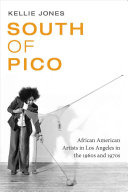
In South of Pico Kellie Jones explores how the artists in Los Angeles's black communities during the 1960s and 1970s created a vibrant, productive, and engaged activist arts scene in the face of structural racism. Emphasizing the importance of African American migration, as well as L.A.'s housing and employment politics, Jones shows how the work of black Angeleno artists such as Betye Saar, Charles White, Noah Purifoy, and Senga Nengudi spoke to the dislocation of migration, L.A.'s urban renewal, and restrictions on black mobility. Jones characterizes their works as modern migration narratives that look to the past to consider real and imagined futures. She also attends to these artists' relationships with gallery and museum culture and the establishment of black-owned arts spaces. With South of Pico, Jones expands the understanding of the histories of black arts and creativity in Los Angeles and beyond.
1 note
·
View note
Photo
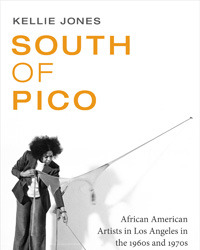

Two books on Los Angeles artists I just checked out from the library.
South of Pico: African American Artists in Los Angeles in the 1960s and 1970s
Kellie Jones (2017)
In South of Pico Kellie Jones explores how the artists in Los Angeles's black communities during the 1960s and 1970s created a vibrant, productive, and engaged activist arts scene in the face of structural racism. Emphasizing the importance of African American migration, as well as L.A.'s housing and employment politics, Jones shows how the work of black Angeleno artists such as Betye Saar, Charles White, Noah Purifoy, and Senga Nengudi spoke to the dislocation of migration, L.A.'s urban renewal, and restrictions on black mobility. Jones characterizes their works as modern migration narratives that look to the past to consider real and imagined futures. She also attends to these artists' relationships with gallery and museum culture and the establishment of black-owned arts spaces. With South of Pico, Jones expands the understanding of the histories of black arts and creativity in Los Angeles and beyond.
youtube
[Talk on South of Pico by Kellie Jones, Feb 20, 2018 at the Hammer Museum]
Building on her work on the Hammer exhibition Now Dig This! Art and Black Los Angeles, 1960–1980, Jones expands our understanding of the history of black arts in Los Angeles and beyond. She is joined by artist and founder of the Brockman Gallery Dale Davis, UCLA professor of English Uri McMillan, and UC Irvine professor of Art History and African American Studies Bridget Cooks.

[Judy Fiskin, from Dingbat series, 1982, via American Suburb X: “When I first started I was really interested in atmosphere. I’ve developed away from that, but that’s true of the first stucco bungalows that I did and then the stuff I did in San Bernardino – and even the military bases to some extent. I was interested in a sort of Raymond Chandler atmosphere – too much sunlight, making you squint, everything really menacing. That’s how I picked San Bernardino. I grew up in Southern California, and on my childhood map, after San Bernardino there was a big void that you would fall into if you went any farther.”]
Creating the Future Art and Los Angeles in the 1970s
Michael Fallon (2014)
Conceived as a challenge to long-standing conventional wisdom, Creating the Future is a work of social history and cultural criticism that examines the premise that the progress of art in Los Angeles ceased during the 1970s — after the decline of the Ferus Gallery, the scattering of its stable of artists (Robert Irwin, Ed Kienholz, Ed Moses, Ed Ruscha and others), and the economic struggles throughout the decade — and didn’t resume until sometime around 1984 when Mark Tansey, Alison Saar, Judy Fiskin, Carrie Mae Weems, David Salle, and Manuel Ocampo, among others, became stars in an exploding art market. However, this is far from the reality of the L.A. art scene in the 1970s.The passing of those fashionable 1960s-era icons, in fact, allowed the development of a chaotic array of outlandish and independent voices, marginalized communities, and energetic, sometimes bizarre visions that thrived during the stagnant 1970s. Fallon’s narrative describes and celebrates, through twelve thematically arranged chapters, the wide range of intriguing artists and the world—not just the objects—they created. He reveals the deeper, more culturally dynamic truth about a significant moment in American art history, presenting an alternative story of stubborn creativity in the face of widespread ignorance and misapprehension among the art cognoscenti, who dismissed the 1970s in Los Angeles as a time of dissipation and decline.
2 notes
·
View notes
Link
The first feature in the NY Times and in US journalism in general over the past 10 years to fully grasp the racialized reality of homelessness. The history of outright exclusion from property and homeownership by the state and market is well covered here and mass incarceration, which is good.
Great maps of shelter and housing capacity as well.
Mr. Lynn, the homelessness agency director, pointed to the criminal justice system, saying, “There is probably no more single significant factor than incarceration in terms of elevating somebody’s prospects of homelessness.”
The black overrepresentation in homelessness roughly tracks the same dynamic in California’s prisons: Black people make up about 6 percent of the state's population but about 30 percent of those in prison.
The historic displacement and fracturing of black communities in South Los Angeles have pushed black Angelenos like Mr. Wynn onto the streets at more than eight times the rate of other groups. In interviews with more than a dozen black men who are homeless in Los Angeles, the bitter inheritance of racism came up again and again.
Across the county, a third of black households experience severe rent burdens, with their housing costs equaling half or more of their income.
In South L.A., the share of black households experiencing severe rent burdens is about 50 percent.
South L.A. — once the heart of the city’s black life — is now the epicenter of housing instability for black Angelenos. It is where black residents are most at risk of falling into homelessness.
Latinos in the area do not experience homelessness at nearly the same rate as African-Americans. Experts cite a variety of reasons. Rates of homelessness among white Angelenos are similar to those of Latinos, at about one in 100 residents. Asians and Pacific Islanders in Los Angeles experience homelessness at even lower rates.
But he hasn’t slept in his bed, which still has the plastic cover on it.
He calls the bedroom his “depression room” and sleeps instead on a small black couch. This is not uncommon: some formerly homeless people set up their tents inside their apartments.
0 notes
Text
How Crenshaw became black LA’s main street
Crenshaw Boulevard starts in the middle of bustling, concrete Los Angeles at Wilshire Boulevard and ends in the untamed, unearthly natural beauty of the Palos Verdes Peninsula, a little more than 23 miles away. In between, the heartbeat of historically black Los Angeles pulses at such landmarks as Dulan’s Soul Food, the Los Angeles Sentinel, West Angeles Church, Leimert Park, Baldwin Hills Crenshaw Plaza, and the Paul R. Williams-designed Angelus Funeral Home, where the bodies of director John Singleton and rapper and activist Nipsey Hussle were recently prepared.
At Crenshaw and 50th is the epic Great Wall of Crenshaw, a series of murals depicting black Americans’ contributions to history, created by the street art collective Rocking the Nation in 2000.
“Crenshaw Boulevard is the main street of black LA. Has been, still is, and hopefully always will be,” says Nina Revoyr, activist and author of the acclaimed 2003 novel Southland. “It is a boulevard of both aspiration and disappointments.”
The first section of Crenshaw Boulevard sprang out of the calculated aspirations of Missouri-born developer George L. Crenshaw. In the early 1900s, he began to develop the grand neighborhood of Lafayette Square in the Mid-City section of Los Angeles, then undeveloped ranch land. He decided to name one of the main streets running alongside the development after himself. “In those days, you just went down to City Hall and signed a little slip and that was it,” his grandson Charles Crenshaw told the Los Angeles Times in 2003.
In 1918, a new dirt street, Angeles Mesa Drive, was finished, linking up to Crenshaw Boulevard:
Angeles Mesa Drive, the new short cut route between southwest Los Angeles and the city-to-sea boulevards, is now open to the motoring public from Slauson Avenue to West Adams Street. The new highway shortens by miles the traveling distance between Hyde Park Inglewood, and Redondo districts to the south and southwest of Los Angeles and the west beaches, Hollywood and the San Fernando Valley.
During the building boom of the 1920s, Angeles Mesa Drive gained in importance, as it became the suburban site of new sprawling planned communities. “The paving of Angeles Mesa Drive, is part of a comprehensive plan for the creation of another north-and-south artery beginning at Wilshire Blvd. and extending to the paved county highway a mile south of Adams Street,” the Los Angeles Times reported in 1924. “First steps for the widening of Crenshaw Blvd, of which the Angeles Mesa Drive is a southerly continuance have already been taken.”
In 1925, the Los Angeles Investment Company opened tracts for the upper-class neighborhood of View Park, on the slopes of Baldwin Hills alongside Angeles Mesa Drive. In 1927, the Walter H. Leimert Company hired the pedigreed firm of Olmsted and Olmsted to lay out its planned self-sustaining “community of tomorrow” on 600 acres skirting the boulevard.
Called Leimert Park, this idyllic community featured tree lined streets of elegant homes and apartments designed by architects including Richard Neutra and Sumner Spaulding. In 1932, the Stiles O. Clements-designed Leimert Theater opened in the community’s commercial center. In 1929, Crenshaw Boulevard and Angeles Mesa Drive were finally coalesced into one megastreet.
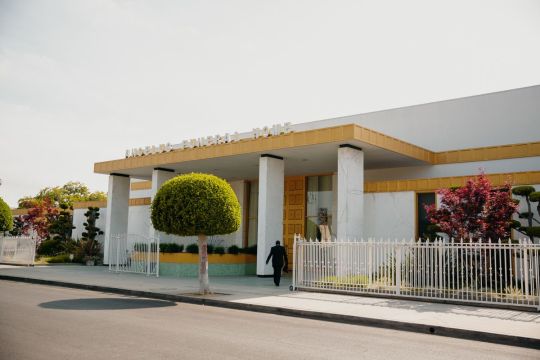
The Angelus Funeral Home is one stand-out building on Crenshaw, and it was designed by architect Paul R. Williams. It’s also where the bodies of Nipsey Hussle and John Singleton were served.
Due to redlining and racially restrictive housing covenants that kept non-whites from living in all but a few areas in LA, the neighborhoods and businesses along what came to be known as “the ’Shaw” were predominantly populated by middle and upper-class white residents. But after the U.S. Supreme Court struck down the racist covenants in 1948, large numbers of successful Japanese Americans began to move into the neighborhoods along Crenshaw. Soon many more black families bought homes in the area as well.
This was an era of great promise for black Angelenos, says longtime Leimert Park resident Lynetta McElroy. “When you talk to some of the older people who came from different areas they said something about Los Angeles blacks was different than anywhere else,” McElroy says. “They had this look. They had fine cars, fine clothes, they had their own clubs. Black culture was rich.”
The addition of these two rich cultures would usher in a golden age of multicultural community on Crenshaw Boulevard. McElroy, who is of African American and Jewish descent, recalls her mother taking her to the annual Japanese-American celebration of Nisei Week in Crenshaw Square. “You would have Japanese dancing and music, food and a carnival,” she says. “You had all the cultures just right here. The ladies were in kimonos, and they were dancing and singing, and they invited the onlookers to learn the dances and sing along.”
McElroy and her African American and Japanese American friends at Crenshaw High also frequented the legendary Holiday Bowl. Perhaps no establishment exemplified the Crenshaw District’s diversity more than this bowling alley and coffee shop at the intersection of 37th and Crenshaw. Designed in the Googie Style by the architect Helen Liu Fong for the firm Armet and Davis, the bowl was opened in 1948 by four Japanese investors. (It was demolished in 2003.) According to KCET’s Ryan Reft:
Early on many of the bowling teams consisted of local Japanese farmers, grocers, and merchants, all of whom competed in divisions that suited their profession: the Gardener’s League, the Produce League, and the Floral League, to name a few. When the area began absorbing greater numbers of African Americans… the teams changed as well. “[M]y team has one black, one Italian, another Japanese, and Korean Sponsor,” Floral League member Dorothy Tanabe told the Los Angeles Times.
Throughout the decades, the Holiday Bowl would continue to be what one longtime employee referred to as a “United Nations.” A high school aged McElroy and her girlfriends spent an intense six weeks at the hangout learning to bowl, determined to earn a letter for their Crenshaw High jackets (she earned it—and still has it today). During the 1970s and ’80s, “that was the go to spot,” says Gina Fields, who grew up all along Crenshaw and lives today in Leimert Park. “It was definitely a cultural hub.”
Revoyr, who is of Japanese American descent, remembers her very first trip to the bowl. “Seeing African American and Japanese American folks of my grandparents age all hanging out together in a coffee shop in such a way that it became clear that these were friendships that existed for decades. That was so beautiful to me,” she says. “Going into the Holiday Bowl and seeing Japanese food and Southern food on the same menu, I just loved that.”

The “Great Wall of Crenshaw” is an important mural that spans 800 feet and incorporates images and icons from black history across the ages.
So important was the Holiday Bowl to the community that during the LA Uprising in the summer of 1992, Rodney King joined with other locals to protect the business from looters, telling potential troublemakers that the bowl was “our place.”
“When I think about Crenshaw—in particular, when I think about a place like the Holiday Bowl, and that whole strip right there, it represents the best version of a polyglot LA—people who are both very, very clear and very proud of who they are as individuals and families, but also who can feel part of a larger collective whole in a way that’s cross racial,” Revoyr says.
The Japanese American influence can still be seen in the bonsai trees and plantings in the yards of the small Mediterranean and Spanish style homes off Crenshaw. However, by the late 1960s, many of the communities surrounding Crenshaw Boulevard, from wealthy View Park, Lafayette Square, and Baldwin Hills to working-class Inglewood, had become mainly associated with black Angelenos.
Black-owned businesses flourished, while farther down the ’Shaw in Hawthorne, aerospace companies offered good employment for many local residents. Glass-plated, modernist car dealerships opened up and down Crenshaw Bouelvard, providing more employment for South LA residents.
Every year, the Martin Luther King Day Parade would travel down Crenshaw Boulevard (it now goes through King Boulevard), and the community would come out to watch. “I remember playing my flute in the band as the Audubon Elementry School band walked down Crenshaw Boulevard,” Fields says. “Later I became a naval cadet and marched with the Youth Naval Cadet when I was 15, and we got all dressed up in our dress uniforms, and it was just such a proud feeling to be able to march... down Crenshaw Boulevard with the crowd cheering.”
Leimert Park became an artistic mecca for artists, artisans, and venues, such as the famed blues club Babe’s & Ricky’s Inn. Its small village green just off Crenshaw Boulevard became a community gathering place for festivals, jazz concerts, and press conferences. At the hip cave-like musical venue Maverick’s Flat, acts like the Ike and Tina Turner Review, The Temptations, Billy Preston, and Parliament-Funkadelic played packed shows while locals and celebrities like Marlon Brando, Sonny Liston, Steve McQueen, and Muhammad Ali danced along.
Many fly dancers at Maverick’s Flat would appear on Soul Train, which debuted in 1970, and transported South LA cool across the country. Host Don Cornelius would also source telegenic and talented dancers from local Crenshaw area high schools. Musician Patrice Rushen recalled in the LA Times hanging out at a local park only to be approached by none other than Cornelius himself. “Anybody who wants to go, we’ll have buses and take you to the TV studio,” he told the high schoolers. “All you’ve got to do is come on the show and dance.”

Young men talk to three young women in their car at the usual gathering spot along Crenshaw Blvd on a Sunday afternoon in 1996.
Photo by Gary Friedman/Los Angeles Times via Getty Images
It was also during this same period, while the Soul Train bus picked up dancers on the ’Shaw, that young men and women began cruising Crenshaw Boulevard on Sunday nights, showing off their tricked lowriders and speaker systems. By the 1980s, cruising had become a weekly ritual on the ’Shaw. “I would come home from Berkeley for the summer and Crenshaw Boulevard was just lively!” Fields says. “You’d see all these low riders, decked out cars, parked in front of the Wienerschnitzel. And we’d hang out. And my mom was like ‘You know you’re not over there hanging out on Crenshaw!’ ‘No Mom.’ And my sister and I were out there—hanging out with all the lowrider cars. It was just such a fun neighborhood.”
Cruising reached its peak in the early 1990s, when more than a thousand cars would jam Crenshaw Boulevard, from Jefferson Boulevard to Florence Avenue. Faced with mounting pressure by frustrated Crenshaw Boulevard business owners and civic leaders, in 1994 the LAPD began to barricade 3.5 miles of Crenshaw, from Adams to 78th street, every Sunday night. But this and other deterrents had little effect, with cruisers simply going farther south on Crenshaw or taking side streets. In April 1995, a popular Banning High football player named Dupree Taye was shot and killed in a random act of violence when the red Ford Thunderbird he was cruising in got a flat tire.
Violence would become an epidemic during the late 1980s and early ’90s, as gangs and drugs and social, educational, and economic inequities wreaked havoc on many communities in South Los Angeles.
During this time period, Crenshaw Boulevard would become legendary in popular culture, with films such as Singleton’s Boyz in the Hood, and artists from the area including Eazy-E, Ice-T, Ice Cube, and Dr. Dre rapping about the hard realities that faced many South LA youth. There also more lighthearted homegrown acts like Skee-Lo, who penned an ode to Sunday night cruising on the 1995 track “Crenshaw”:
Who me I’m Skee, I rap and produce
Pull over I wanna know you and my crew wants to know your crew
Now how them cheeks fit in the seat of that Jeep
See this is type of freak that could be cool for me
I like her style she like my style I make her smile she think I’m funny
Won’t front it be pump rollin Crenshaw on Sunday
After the LA Uprising, some middle class black Angelenos left South LA for safer areas in the city. Throughout the ’90s and 2000s, Latinos began to arrive in greater numbers, and some of the boulevard’s historically black-owned businesses began to close. Years of disinvestment in resources and infrastructure by the city and state also took their toll.
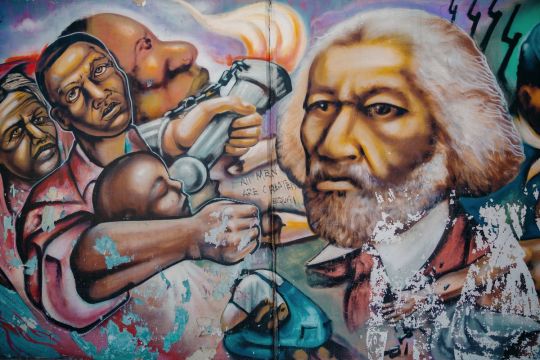
The “Great Wall of Crenshaw” is an important mural that spans 800 feet and incorporates images and icons from black history across the ages.
In 2008, the construction of the 8.5-mile Crenshaw/LAX light rail line was announced by Metro. Although a fight to add a stop at Leimert Park, called by Singleton “the black Greenwich Village,” was successful, the plan deeply polarized communities along Crenshaw Boulevard. This and the encroaching gentrification of areas like Leimert Park led to the formation of Destination Crenshaw, a planned 1.3-mile cultural district spanning Crenshaw Boulevard from 48 to 60th streets.
“Destination Crenshaw came about as a result of conversations related to the building of the Crenshaw/LAX Metro line and the controversy in the community that remains to this day about the portion between Hyde Park and Leimert Park being built at grade,” says Los Angeles City Councilmember Marqueece Harris-Dawson, who grew up visiting his grandfather at his real estate operations on Crenshaw Boulevard. “Folks were very, very upset. Folks were like, ‘this is the African American community’s major street.’ In no other major street in Southern California does Metro build rail at grade.”
Building at grade would cause major disruption on the street, splitting it in two and making it less a walkable main street and more like a drive-though thoroughfare. Community and civic leaders decided to turn what they saw as an insult into an opportunity. “Folks came up with the idea of an open-air people’s museum,” Harris-Dawson says. “The African American history of Los Angeles is extremely rich—as rich as any city in the country. And that there ought to be a place, like we have Chinatown, like we have the Fairfax district, like we have Little Tokyo, like we have San Pedro... that calls out the contributions of African Americans building this region.”
Targeted to be completed in spring 2020, Destination Crenshaw will include 100 permanent art installations extolling the history and culture of black Angelenos. The Leimert Theater is being fully restored and modernized, and there are plans for a public amphitheater and 10 new parks and miniparks.
The architecture firm of Perkins and Will will oversee the design and construction. Landscape design will be provided by Studio-MLA. “What we hope is that we build a cultural hub and that people can actually consume African American culture in these locations,” Harris-Dawson says. New housing is being built along the under-construction Crenshaw/LAX line, and efforts to spruce up the boulevard can be seen all around, including in the planned restoration of the Great Wall of Crenshaw.
“With Destination Crenshaw, our working tagline was ‘unapologetically black,’” says Ron Finley, an artist and community activist known as the Gangsta Gardener. “There’s nothing in Los Angeles that celebrates black Los Angeles. Destination Crenshaw is going to be just that. It is going to be proudly, historically black—it’s going to be super black.”
Another community partner involved in Destination Crenshaw was the rapper, philanthropist, and civic leader Nipsey Hussle. On March 31, Hussle was murdered outside his Marathon Clothing Store on Slauson Avenue, just off Crenshaw. His death devastated both the old and young in South LA.

Mural of Nipsey Hussle on the corner of Crenshaw and Slauson.
“He was a guy who saw beauty in a place that other people just dismissed as unworthy and desolate and as less than,” Revoyr says. “And I think that in elevating the Crenshaw area with his obvious love and respect, he made the young people who live there feel that they were respected.”
But those leading Destination Crenshaw are determined Hussle’s innovative work and ideas will live on. “He had this project and this program called ‘All Money In,’” Harris-Dawson says. “Our community creates value, especially in the realm of culture. Except the community doesn’t benefit from the creation of that value, and so if young people in South LA make a sneaker popular or a t-shirt popular, you then have to go to Melrose to buy the t-shirt!”
Through Destination Crenshaw and other programs, the councilmember aims to bring money and foot traffic onto Crenshaw Boulevard, creating value that stays within South Los Angeles. “I think that there’s great potential with the Metro line,” Revoyr says. “More people are going to be coming through Crenshaw hopefully with the line opening… and the Destination Crenshaw project should be a draw.”
But there are concerns. “There is understandably a lot of anxiety about what that’s going to do to property in terms of affordability,” Revoyr says. There is also still much work to be done on other parts of Crenshaw Boulevard. “As you go farther south... the disinvestment of public resources becomes more and more evident.”
Longtime residents like Fields and McElroy also worry that the rail line, along with gentrification and development in single-family neighborhoods, will obliterate their close-knit feel and its rich heritage.
“We all know each other. We all watch out for each other. I recognize every neighbor on my street... Despite the fact that it’s in the middle of a big city smack dab in the middle of a very large city, [Leimert Park] is this cute small little neighborhood that’s fun to just walk around and wander around and just meet people,” Fields says.” I hope that with all the progress that’s being proposed and all the developments that are coming that we’re able to maintain the uniqueness of the neighborhood.”
Along with these vibrant patches of community and culture, there are stretches of the boulevard almost like ghost towns, where boarded up businesses are the norm. For Revoyr, Crenshaw Boulevard remains a street of contradictions. “You see these buildings and these places of great beauty and great promise and then you have at Crenshaw and Slauson Nipsey Hussle murdered in front of his store,” she says. The ’Shaw is a street rich in history, art, commerce and culture, but it has the potential to be so much more.
Source: https://la.curbed.com/2019/5/17/18563304/crenshaw-blvd-los-angeles-nipsey-hussle-history
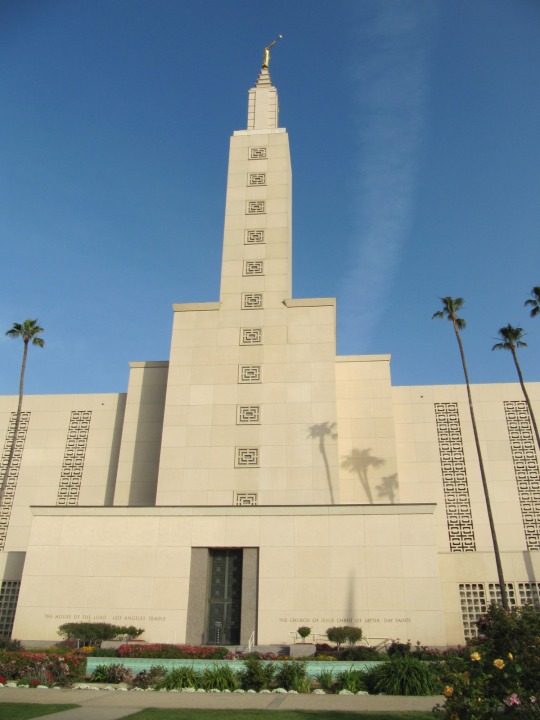
0 notes
Text
Timeline: 25th Anniversary of the 1992 L.A. Riots

This year marks the 25th anniversary of the L.A. riots that erupted on April 29, 1992.
Our timeline explores the history of African Americans in Los Angeles and the conditions that led to the L.A. Riots.
The 2nd Great Migration: 1940s-1970s
During the 2nd Great Migration, from 1940-1970, millions of African Americans left the segregated South for cities in the North and West during the Great Migration. The movement from the South was carried out by ordinary people making individual choices—in search of better opportunities.
Los Angeles gained an influx of African Americans from the South and the population rose from 63,000 to over 736,000.
Urban Housing Discrimination
The second Great Migration would expose the racial divisions and disparities that also existed in northern cities.The new arrivals were faced with racially restrictive housing covenants. Shelley v. Kraemer overturned this practice in 1948.
Housing segregation made it more difficult to deal with issues of unemployment, education, health, and crime. As a result, racial tensions were high in poorer black neighborhoods like Watts.
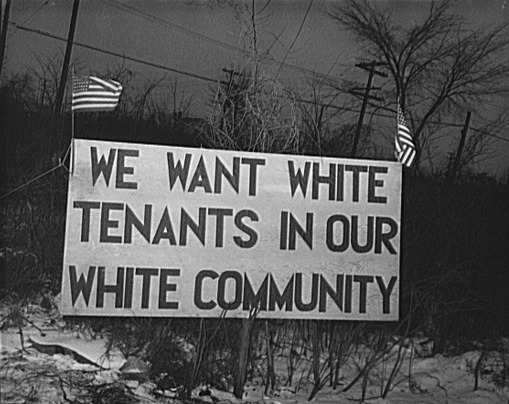
Photo: sign with American flag "We want white tenants in our white community," directly opposite the Sojourner Truth homes, a new U.S. federal housing project in Detroit, Michigan. A riot was caused by white neighbors' attempts to prevent Negro tenants from moving in, Arthur S. Siegel.
In the 1950s, street clubs formed to protect minority neighborhoods against racial violence. Young Black Angelenos formed street clubs like The Devil Hunters, The Farmers, and The Huns.
The Civil Rights Act passed in 1964, but some states circumvented the law and kept de facto segregation in their inner cities.
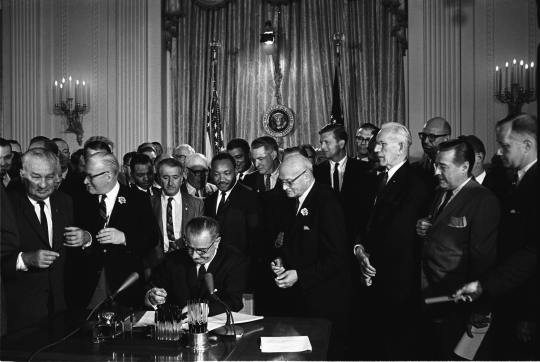
Photo: President Lyndon B. Johnson signs the 1964 Civil Rights Act as Martin Luther King, Jr., and others, look on, Cecil Stoughton, White House Press Office.
1965 Watts Riots
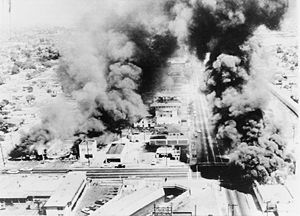
Photo: Burning buildings during Watts Riots, LOC, New York World-Telegram.
Despite the 1964 Civil Rights Act, California continued to allow segregation. There were also widespread reports and complaints of police brutality in South Central, stemming from a military-like police led by Police Chief William Parker. The Watts riots of 1965—precipitated by the arrest of an African American motorist—led to violence, 34 deaths, and millions of dollars in damages. More than 34 people die, 1,000 are wounded, and millions of dollars worth of property is damaged during the unrest.
The Rise of Black Power: 1970s

Photo: Black Power, © Roderick Terry, Collection of the Smithsonian National Museum of African American History and Culture, Gift of Roderick Terry.
Following the Watts Riots, the Black Power Movement gained national recognition. Black Power emphasized black self-reliance and self-determination more than integration. Proponents believed African Americans should secure their human rights by creating political and cultural organizations that served their interests. They insisted that African Americans should have power over their own schools, businesses, community services, and local government. They focused on combating centuries of humiliation by demonstrating self-respect and racial pride as well as celebrating the cultural accomplishments of Black people around the world. The Black Power Movement frightened most of white America and unsettled scores of Black Americans.
1992 L.A. Riots
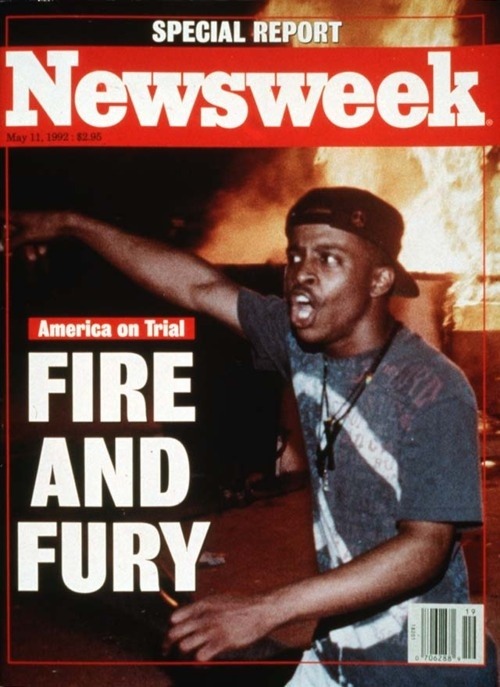
Photo: The May 11, 1992 issue of Newsweek magazine featuring a special report on the Rodney King riots in Los Angeles. Collection of the Smithsonian National Museum of African American History and Culture, Gift of the documentary “Everyday Sunshine: The Story of Fishbone.”
“A riot is the language of the unheard.” - Martin Luther King Jr.
On April 29, 1992, Sgt. Stacey C. Koon and Officers Laurence M. Powell, Theodore J. Briseno, and Timothy E. Wind are acquitted of assault and use of deadly force by a jury in Simi Valley.
Fires, looting, and violence spread. Mayor Tom Bradley declares a state of emergency and Gov. Pete Wilson activates the National Guard.
Over the next few days, crowds of residents face off against hundreds of L.A. police officers and 16,000 National Guard members.
Follow the timeline below for more information on the 1992 L.A.Riots.
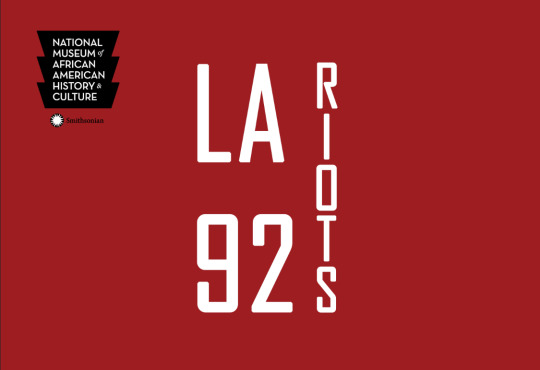
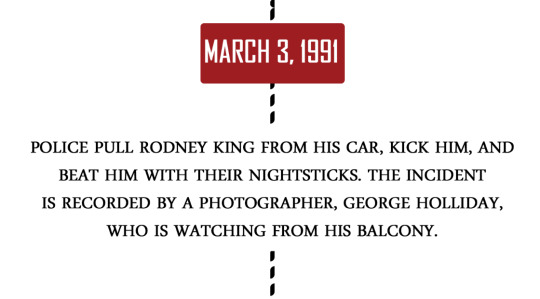
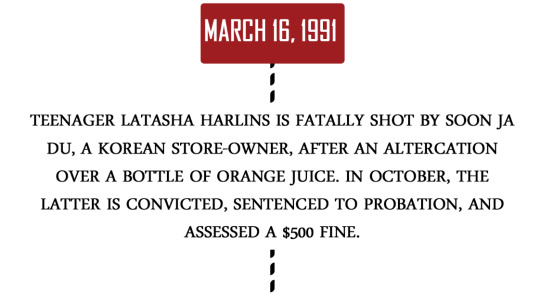
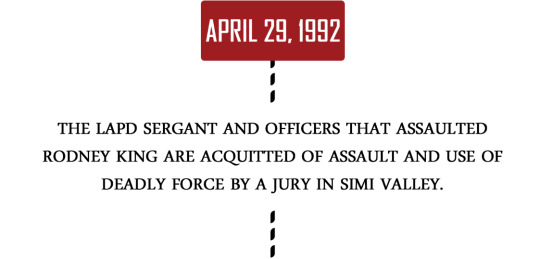
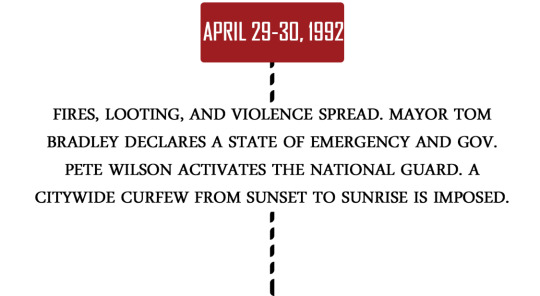
Join us at 7pm as we host History, Rebellion, and Reconciliation: The L.A. Uprising 25 Years Later in collaboration with the Smithsonian Asain Pacific American Center. We will explore the different perspectives that African Americans and neighboring communities of color have on the L.A. riots. Watch the event live and join the social conversation with #LA92 and #HRRLive.
71 notes
·
View notes
Text
Living through Covid-19 while Black and homeless

Not too many people do what Luther Keith does. Keith walks the streets among the homeless, passing out clothes and serving the unhoused with hot meals. This has been an everyday occurrence for Keith for over two decades.
On a weekly basis, Keith donates his time and feeds hundreds, sometimes thousands.
“That was my mission back in 1999, [that’s] to feed the homeless,” said Keith. “I started doing this on Avalon and Imperial Highway back in 1999 when I was at Locke High [School].”
At the time of his calling to help out those on the streets, Keith was a security officer for Locke High School in an area previously known as Watts, which is now encompassed inside of the boundaries of South Los Angeles.
A longtime gang interventionist, Keith has a strong presence on the streets of South Los Angeles. Working as the head of security for the renowned Drew League, a pro-am summer basketball league that has become home in the offseason for many NBA players, and keeping the peace among warring gang factions, Keith is a doer and not a talker when it comes to helping others.
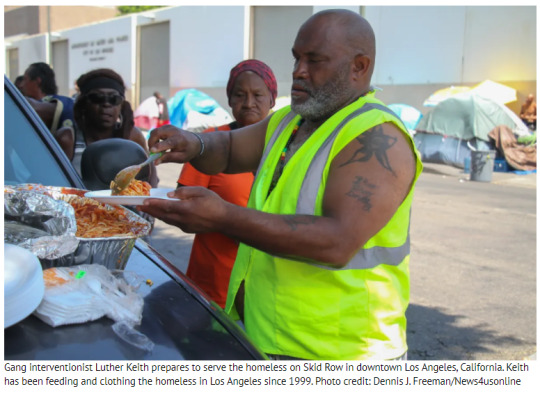
Feeding and clothing the homeless is not for the faint of heart. Driving through downtown Los Angeles one can encounter many things. First, the many skyscrapers silhouettes that outline the Southern California skies make for a breathtaking view.
There are local hotspots and eateries that pop up on just about every block of the downtown area that make it chic or trendy to wine and dine.
STAPLES Center, the place that the Los Angeles Lakers and Los Angeles Clippers call home, is snuggled in the midst of all of this hustle and bustle. Right across the street sits the Microsoft Theater, where live concerts from some of the biggest names in the music and entertainment industries are constantly on display as artists come and pay a visit when they’re in town performing.
Then there is Skid Row which is the direct antithesis to everything that is glamorous and modern in the downtown area of the second-largest city in America.
Though it is located in the downtown area of Los Angeles, a person would have to go through nearly two miles of designated parking lots and clumps of buildings and go past the city’s Los Angeles Fashion District before encountering humanity at its worse.
Skid Row is a proliferation of tents, gangs, hustlers, prostitution, gambling, and drug activity. The streets are blackened by the large amounts of trash and debris that have settled on them. The air space is almost inhalable. Assaults and robberies can happen about as quickly as you snap your fingers.
Navigating through Skid Row and other parts of downtown Los Angeles can be a dangerous place to walk or drive. The Covid-19 pandemic has magnified the danger alert to an even greater level. Keith is not too concerned about it. That’s because as a devout Christian, Keith arms himself with the faith weapons he’s been given on his sleeves.
These are the antidotes to any negativity he may encounter when he’s out and about doing what he’s called to do.

Judge David O. Carter gave the elected officials representing the City Los Angeles and Los Angeles County a sharp rebuke for failing to properly address the homeless crisis. The judge issued a memo ordering those living on Skid Row to be housed by this fall.
“There can be no defense to the indefensible,” Carter wrote in a 110-page ruling in the court case LA Alliance for Human Rights v City of Los Angeles. “For all the declarations of success that we are fed, citizens themselves see the heartbreaking misery of the homeless and the degradation of their City and County. Los Angeles has lost its parks, beaches, schools, sidewalks, and highway systems due to the inaction of City and County officials who have left our homeless citizens with no other place to turn. All of the rhetoric, promises, plans, and budgeting cannot obscure the shameful reality of this crisis—that year after year, there are more homeless Angelenos, and year after year, more homeless Angelenos die on the streets.”
The system of homelessness has become a Black problem with long-rooted institutional checks and balances in place playing a significant role behind the scenes, said Heidi Marston, director of the Los Angeles Homeless Services Authority.
“I want to be very clear, homelessness is a byproduct of racism,” Marston said. “We continue to see that Black people are overrepresented in our homeless population and that Black African Americans are four times more likely to become homeless than their white counterparts.”
Being homeless and Black in the middle of the Covid-19 is not just a Los Angeles thing. The numbers are just as staggering nationally. Much like the population-to-homeless ratio in Los Angeles, unhoused statistics for Blacks across the country are alarming.
According to the 2020 Annual Homeless Assessment Report (AHAR) to Congress, a report backed by the U.S. Department of Housing and Urban Development, 39 percent of the people who are homeless nationwide are Black. The AHAR report, released this past January, also concluded that Blacks with families and children (53 percent) are in far greater numbers to be homeless than any other ethnic group surveyed.
According to a 2020 U.S. Census study, Blacks are just 12 percent of the general population in the country, a sobering reality to the vast homelessness numbers this group represents. There are several contributing factors as to why many Black people can be found on the streets or are unsheltered, according to the National Alliance to End Homelessness.
The main causes, poverty, rental and housing discrimination, lack of access to quality health care and incarceration, are nothing new. When it comes to re-entering back into society after being incarcerated, Black women are more likely than anyone else to be homeless, according to the Prison Policy Initiative. That’s including Black men.
A New Way of Life Reentry Project, founded by Susan Burton, does its best to address the needs of these women once they leave jail or prison.
“A New Way of Life and similar programs offer people released from jails and prisons an opportunity to live in a safe, welcoming, structured, and supportive environment where both staff and other residents understand the challenges that convicted and formerly incarcerated people face, and are able to offer a clear path forward,” said Pamela Marshall, co-director of A New Way of Life Reentry Project.
“Having stable, safe and affordable housing improves an individuals’ abilities to reduce stress; to heal from trauma or addiction; to manage a health or mental health condition; to find and maintain employment; to protect, uplift and support children and other family members; to attend school and/or job training programs; to avoid violence and system contact,” Marshall added.
Based in South Los Angeles, A New Way of Life Reentry Project has 10 homes to accommodate women coming from jail or prison. Marshall said once these individuals put incarceration in the rearview mirror, trying to live and function in normalcy, can be overwhelming.
“Imagine living in a jail or prison cell where your every movement, every minute, every meal and every decision has been made for you and you are suddenly released with $200 or less, without a state ID, social security card, medical or birth documents, into a world where the technology, bus routes, culture, and communities have advanced far into the future leaving you without direction or understanding and you have also lost all contact with family, friends or a place to stay,” Marshall said.
While A New Way of Life Reentry Project has a more structural way of helping those once locked up to stay off the streets, Keith keeps things pushing with his charitable outreach, bringing encouragement and food to fill the bellies and minds of the homeless. And he does it without fear.
“If you ain’t equipped and know how to do this…they got gangs down there,” Keith said. “Folks are scared to go down there.”

1 note
·
View note
Photo
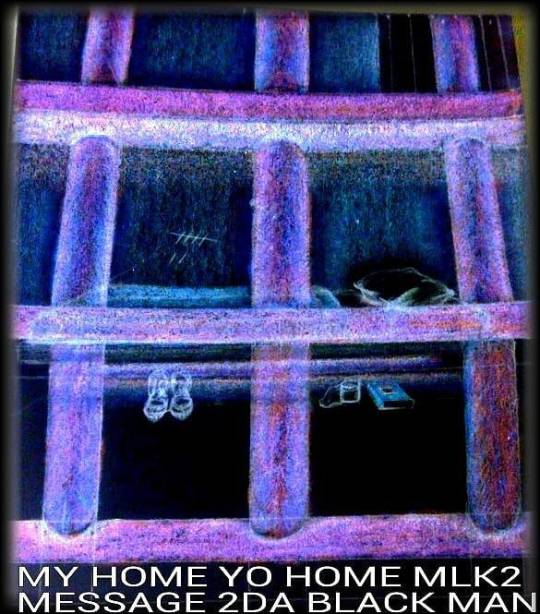
AMERICAN NEGRO: A MIGRANT'S STORY Listen to the drum beat drum beat From my West African Motherland to an island in the Caribbeanne Listen to the drum beat drum beat Listen to my heart weep heart weep To a plantation in a Southern State to Emancipation from which I could not escape Listen to the drum beat drum beat Listen to my heart weep heart weep Back to enslavement because the 13th Amendment says they can because of convict leasing just ask any historianne Listen to the drum beat drum beat Listen to my heart weep heart weep Went home to the Maker from being hung from a tree cause the Ku Klux Klan thought that’s how it ought to be Listen to the drum beat drum beat Listen to my heart weep heart weep Jim Crow a great friend of the Klan so I left the South to become a Chicagoanne Listen to the drum beat drum beat Listen to my heart weep heart weep Congress cut off funding for Wars in foreign lands created a drug called Crack from the Columbian Hinterlands Started a Drug War aimed at the Black community and locked us all up with impunity Listen to the drum beat drum beat Listen to my heart weep heart weep Now I’m a part of this new diaspora from Miami, L.A., Brooklyn to Peoria 21st Century Jim Crow. Now a penitentiary cell is my new home Back to bread and water being a full-course meal just like an 1841 so what’s the big deal THIS IS THE AMERICAN NEGROS’ MIGRANT STORY went from a plantation Hell to a Warden’s prison cell Now we’re just lonely and alone and the songs we once heard we don’t hear no moe “Brotha over there in the next cell, ‘Are you still listening for the drum beat the drum beat?’ I don’t” Oh Lord, just put my heart to sleep heart to sleep American Negro: A Migrant’s Story by Donald “C-Note” Hooker Artwork by C-Note About Artist: Donald "C-Note" Hooker is a native angeleno. He is a poet, playwright, performing artist, award winning visual artist, and the King of Prison Hip Hop. His works have either been exhibited, performed, or sold, from Alcatraz to Berlin. In 2017, Google Search listed him as both America's and the world's most prolific Prisoner-Artist. ##darealprisonart #hiphop #poet #performingartist #playwright #Love #art #artist #blackart https://www.instagram.com/p/Bsk98PXF3K0/?utm_source=ig_tumblr_share&igshid=dwylt8eijgh3
0 notes
Text
Resharing videos of violence against Black people can spark more trauma
A mural in Minneapolis, Minnesota, made by community artists, commemorates George Floyd, who was killed while being restrained by city police officers in May. Video of his death, taken primarily by a teenager, has since flooded the internet. (munshots/Unsplash/)
The next time you decide to hit the retweet button, think again. That video of Derek Chauvin pressing his knee into George Floyd’s neck for nearly nine minutes could have deleterious mental health impacts on the Black community.
From abolitionist Frederick Douglass’ essays on the horrors of slavery to ad hoc social media footage of police brutality, the documentation of brutality against Black people is nothing new. But in this era, in which the power of a camera lies at nearly everyone’s fingertips, the stories have taken a visceral, viral turn.
On March 3, 1991, George Holliday stood on a balcony across from Hansen Dam Park in Los Angeles, filming four officers as they beat and tased Rodney King. This was the first police-brutality video of its kind—nationally circulated on television and massively powerful. After the four officers were proclaimed not guilty, Los Angelenos protested for five days.
Since then, videos have played a crucial part in anti-racism and anti-police-brutality demonstrations. In the last few months, clips of Ahmaud Arbery’s and George Floyd’s murders instigated a nationwide outcry that resulted in the arrest and charge of the perpetrators. Footage of the deaths of other Black men and women continues to be released each week.
The power of video is undeniable—but the net effect isn’t always positive. While they can quickly spread awareness of brutal racial violence and prompt outrage, they also continuously inflict racial trauma on the Black community with each retweet and reshare. Could these videos be doing more harm than good?
Trauma through the screen
In a 2018 study published in The Lancet, Boston University researchers found that in the two months following the murders of Black individuals by police, Black individuals living near the crime scene experienced significant deterioration in mental health, along with symptoms of trauma. While most people didn’t directly witness the violence, the dissemination of videos and news reports still caused longstanding mental health problems.
Allissa Richardson, an assistant professor of journalism and communication at the University of Southern California, refers to ubuntu, which means “I am because we are” in the southern African language of Nguni Bantu. “It states that we are interconnected,” Richardson says. “I see my own self in you. That could be my dad lying there, getting the life squeezed out of him. So I can not watch.”
Many compare race-based trauma to vicarious trauma, which typically impacts health care workers, counselors, and psychologists who feel the residual emotional impact of other peoples’ experiences. But University of Ottawa psychologist Monica Williams, who specializes in race-based trauma, clarifies that the two can’t be compared.
The trauma that Black people face is more vivid and personal, she says. “They are seeing members of their own community brutalized. There’s a level of direct threat that’s not necessarily present when a client is describing a story to a counselor.”
“The videos are passed around like popcorn at the theater,” Williams adds. “The images aren’t treated with the same dignity and respect that you’d give to anyone else.” After seeing the barrage of violent clips on social media and the news, Black people may experience stress and mental health symptoms such as crying, depression, severe lack of motivation, low self-esteem, and a chronic inability to focus and concentrate, she says. According to the US Department of Health and Human Services, Black Americans are 20 percent more likely to report severe psychological distress than their white counterparts. At the same time, they’re less likely to seek out treatment, due to a chronic lack of health resources in their neighborhoods and a historic lack of trust with hospitals and doctors.
Ida B. Wells, seen here with her four children, led an investigative series on lynchings in Southern states during the 1890s. She published those with the NAACP, which she helped found. (Courtesy of the Ida B. Wells Memorial Foundation/)
Into the shadow archive
Ultimately, non-Black social media users and journalists have a responsibility to treat these videos more sacredly. Part of that means looking at their sharing behavior after other traumatic events. The deaths of white people, for instance, are rarely broadcast on national television; in the case of the 2017 Las Vegas mass shooting, the initial torrent of footage was largely replaced with more respectful portraits of the victims.
Where did the videos of the tragedy go? Into what is called the “shadow archive,” says Richardson, who recently published a book exploring the lives of journalist-activists as they documented Black Lives Matter through their smartphones. The “shadow archive” can be tangible (like a museum or a library) or metaphorical—a place where images of death can go to rest and only be accessed by those who wish to view them out of respect, education, and awareness. The idea originated with Ida B. Wells, a trailblazing investigative journalist in the early 20th century, who frequently dispatched white photographers to document lynchings in the South, and published the photos in the NAACP’s magazine, The Crisis. Once the images reached full circulation and incited lobbying for anti-lynching laws, the organization placed them in a metaphorical shadow archive, preventing them from being published again.
The transition serves a moral purpose, but it can benefit people’s mental health, too. What’s more, it leaves room for a deeper representation of Black individuals on social media and the news. When Black women and men die on camera, media companies broadcast them with the same casual air of a sports highlight, Richardson says. “I’m calling for us to use these pictures judiciously. Not doing so at this point [denies] Floyd the same dignity we’ve given white victims.” While it may be difficult to encourage companies like Google and Facebook to keep these videos from resurfacing on their feeds, social media users have the power of making a shadow archive of their own—simply by declining to hit a button or two.
0 notes
Text
Resharing videos of violence against Black people can spark more trauma
A mural in Minneapolis, Minnesota, made by community artists, commemorates George Floyd, who was killed while being restrained by city police officers in May. Video of his death, taken primarily by a teenager, has since flooded the internet. (munshots/Unsplash/)
The next time you decide to hit the retweet button, think again. That video of Derek Chauvin pressing his knee into George Floyd’s neck for nearly nine minutes could have deleterious mental health impacts on the Black community.
From abolitionist Frederick Douglass’ essays on the horrors of slavery to ad hoc social media footage of police brutality, the documentation of brutality against Black people is nothing new. But in this era, in which the power of a camera lies at nearly everyone’s fingertips, the stories have taken a visceral, viral turn.
On March 3, 1991, George Holliday stood on a balcony across from Hansen Dam Park in Los Angeles, filming four officers as they beat and tased Rodney King. This was the first police-brutality video of its kind—nationally circulated on television and massively powerful. After the four officers were proclaimed not guilty, Los Angelenos protested for five days.
Since then, videos have played a crucial part in anti-racism and anti-police-brutality demonstrations. In the last few months, clips of Ahmaud Arbery’s and George Floyd’s murders instigated a nationwide outcry that resulted in the arrest and charge of the perpetrators. Footage of the deaths of other Black men and women continues to be released each week.
The power of video is undeniable—but the net effect isn’t always positive. While they can quickly spread awareness of brutal racial violence and prompt outrage, they also continuously inflict racial trauma on the Black community with each retweet and reshare. Could these videos be doing more harm than good?
Trauma through the screen
In a 2018 study published in The Lancet, Boston University researchers found that in the two months following the murders of Black individuals by police, Black individuals living near the crime scene experienced significant deterioration in mental health, along with symptoms of trauma. While most people didn’t directly witness the violence, the dissemination of videos and news reports still caused longstanding mental health problems.
Allissa Richardson, an assistant professor of journalism and communication at the University of Southern California, refers to ubuntu, which means “I am because we are” in the southern African language of Nguni Bantu. “It states that we are interconnected,” Richardson says. “I see my own self in you. That could be my dad lying there, getting the life squeezed out of him. So I can not watch.”
Many compare race-based trauma to vicarious trauma, which typically impacts health care workers, counselors, and psychologists who feel the residual emotional impact of other peoples’ experiences. But University of Ottawa psychologist Monica Williams, who specializes in race-based trauma, clarifies that the two can’t be compared.
The trauma that Black people face is more vivid and personal, she says. “They are seeing members of their own community brutalized. There’s a level of direct threat that’s not necessarily present when a client is describing a story to a counselor.”
“The videos are passed around like popcorn at the theater,” Williams adds. “The images aren’t treated with the same dignity and respect that you’d give to anyone else.” After seeing the barrage of violent clips on social media and the news, Black people may experience stress and mental health symptoms such as crying, depression, severe lack of motivation, low self-esteem, and a chronic inability to focus and concentrate, she says. According to the US Department of Health and Human Services, Black Americans are 20 percent more likely to report severe psychological distress than their white counterparts. At the same time, they’re less likely to seek out treatment, due to a chronic lack of health resources in their neighborhoods and a historic lack of trust with hospitals and doctors.
Ida B. Wells, seen here with her four children, led an investigative series on lynchings in Southern states during the 1890s. She published those with the NAACP, which she helped found. (Courtesy of the Ida B. Wells Memorial Foundation/)
Into the shadow archive
Ultimately, non-Black social media users and journalists have a responsibility to treat these videos more sacredly. Part of that means looking at their sharing behavior after other traumatic events. The deaths of white people, for instance, are rarely broadcast on national television; in the case of the 2017 Las Vegas mass shooting, the initial torrent of footage was largely replaced with more respectful portraits of the victims.
Where did the videos of the tragedy go? Into what is called the “shadow archive,” says Richardson, who recently published a book exploring the lives of journalist-activists as they documented Black Lives Matter through their smartphones. The “shadow archive” can be tangible (like a museum or a library) or metaphorical—a place where images of death can go to rest and only be accessed by those who wish to view them out of respect, education, and awareness. The idea originated with Ida B. Wells, a trailblazing investigative journalist in the early 20th century, who frequently dispatched white photographers to document lynchings in the South, and published the photos in the NAACP’s magazine, The Crisis. Once the images reached full circulation and incited lobbying for anti-lynching laws, the organization placed them in a metaphorical shadow archive, preventing them from being published again.
The transition serves a moral purpose, but it can benefit people’s mental health, too. What’s more, it leaves room for a deeper representation of Black individuals on social media and the news. When Black women and men die on camera, media companies broadcast them with the same casual air of a sports highlight, Richardson says. “I’m calling for us to use these pictures judiciously. Not doing so at this point [denies] Floyd the same dignity we’ve given white victims.” While it may be difficult to encourage companies like Google and Facebook to keep these videos from resurfacing on their feeds, social media users have the power of making a shadow archive of their own—simply by declining to hit a button or two.
0 notes
Text
The 9 Best Cookbooks of the Year – Robb Report
Around these parts you’re usually going to find us talking about where we want to go eat next. Let’s leave the hard work of making delicious food to the professionals. However, part of the fun of food can be taking a dish that inspired you and making it yourself at home. And sometimes you want to know the story behind a really great meal or cuisine, because food can be a way to understand creativity and culture.
This year there was a barrage of amazing books by some of the world’s best chefs. From talented husband-wife duos showing you how to create their best dishes at home, to a Michelin two-star chef taking you on an exploration of New Nordic cuisine, to a famed baker revealing her secrets, there was no shortage of tomes to improve your culinary knowledge. Here are the nine we loved the most.
A delightful tour of France.
Photo: courtesy Workman Publishing
Let’s Eat France, by Francois-Regis Gaudry and Friends
It’s had to really describe this book other than saying it’s a damned delight. It’s 1,250 pages of pure Francophilia, complete with maps, charts, recipes, illustrations, and stories about France and it’s gastronomy. Weighing it at nearly six pounds this coffee table book is practically big enough to replace your coffee table outright. And what we especially love is how meandering and broad the book is as you flip through. On one page you’ll find a map that details the signature cookies of each region of the country, turn a few more and there’s a recipe for flan, and then on another section you’ll see Alain Ducasse and Joël Robuchon pitted against each other to see which one had a bigger impact on French fare.
Dinner at one of San Francisco’s best restaurants.
Photo: courtesy Alanna Hale
Rich Table by Sarah and Evan Rich
Meeting while both working in the kitchen at Bouley in New York, Sarah and Evan fled the Big Apple rat race to head west in 2008. Eventually they landed in San Francisco, each finding work in different restaurants before opening Rich Table a half decade ago. Despite their fine dining backgrounds, their restaurant sought to be more casual, yet still creative. Last year they picked up a Michelin star for their “dressed-up everyday food,” that includes porcini doughnuts with raclette dipping sauce, bucatini with puntarella and chicken kin, and sprouted quinoa cakes with summer squash and chevre. Since getting a reservation at Rich Table can be so tough, perhaps buying the book will be the easiest way to enjoy the couple’s food.
A baking guide from the quirky queen of dessert.
Photo: courtesy Clarkson Potter
All About Cake, by Christina Tosi
This book is truth in advertising. Let the quirky genius behind Milk Bar’s delicious creations show you the world of bundts cakes, sheets cakes, cake truffles, microwave mug cakes, and much more. The pages are filled with recipes that channel Tosi’s knack for finding flavors by mining nostalgia, like her Arnold Palmer sheet cake, or the bundt with a cherry cola glaze. Yet she also lets you in on the basics of her cake methods so you can create your own variations.
Spicy Black Beans.
Photo: courtesy Beatriz da Costa
Between Harlem and Heaven, by JJ Johnson and Alexander Smalls
At the Cecil and legendary jazz club Minton’s in Harlem, JJ Johnson—one of America’s best young chefs—and Alexander Smalls teamed up to serve a cuisine they called Afro-Asian. Inspired by a trip to Ghana, they saw how flavors of China and Vietnam traveled to West Africa to create a distinctive and delicious style of food. From rice to cumin to coriander, they explored the flavors they saw spanning across cultures and then incorporated it into their food. Upon returning to the States to cook in New York, they also traced how the African diaspora influenced food around America, like gumbo migrating from Senegal to South Carolina to Louisiana, taking what they learned in Africa, combining it with their personal histories, and creating a distinctive style that they explain in depth in Between Harlem and Heaven. If you don’t feel like cooking from the book, you can always go to the Henry in Manhattan to let Johnson cook for you.
Is it that serious?
Photo: courtesy of Phaidon
A Very Serious Cookbook, Fabian Von Hauske and Jeremiah Stone
From the duo who we declared two of the best young chefs in America comes their debut cookbook. On New York’s Lower East Side Von Hauske and Stone have built a burgeoning empire, starting with their Michelin-starred tasting menu restaurant Contra, expanding to the wine bar everyone loves Wildair, and now partnering with Anthony Mangieri to create the new Una Pizza Napoletana. The book is a playful look at their food, which has a minimalistic appearance that belies the craft and thought behind their delicious dishes from their pommes darphin with uni to their lavender ice cream with strawberries.
Razor clam and fresh peas
Photo: Courtesy of Gentl and Hyers
Aska, by Fredrik Berselius
Born and raised in Stockholm, Berselius first ventured to New York City in 2000 and after years of cooking, the Swede opened a pop-up restaurant called Frej that shared a space with a ramen joint. Eventually he made his New Nordic tasting menu restaurant permanent, opening the original incarnation of Aska. He would close that restaurant and for two years imagine a new one, creating a restaurant inside an 1860s warehouse on the Brooklyn side of the Williamsburg Bridge. The praise was effusive out of the gate, garnering three stars from the New York Times and two Michelin stars not long after opening. This book, Aska, is the journey of building that acclaimed restaurant and the space it resides in.
Surf and turf.
Photo: courtesy Quentin Bacon
Matty Matheson: A Cookbook, by Matty Matheson
The host of Viceland’s cooking show It’s Suppertime lives life to the fullest. At one point, too full, he’ll admit, having heart attack at just 29 years old. Now Matheson is clean and sober, but still passionate about food. In his new cookbook the charismatic chef tells the story of growing up in Eastern Canada, then cooking at restaurants in Toronto. The first half of the book is devoted to classic seafood dishes like you’d find on Prince Edward Island, while the second half is rooted in classic French bistro fare he cooked in his early jobs, and the gastropub fare he’d later serve like Vietnamese steak tartare and buffalo sweetbread sliders.
Roasted bone marrow.
Photo: courtesy Sierra Prescott
Bestia: Italian Recipes Created in the Heart of L.A., by Ori Menashe and Genevieve Gergis
The husband-and-wife team behind two of LA’s best restaurants—Bestia and Bavel—reveal the dishes that made their debut Italian restaurant such a hit. With Menashe handling the savory side he shows the pastas, pizzas, appetizers, and grilled dishes that are so bold and flavorful that jaded Angelenos were willing to get in their cars and venture to a part of Downtown LA most had probably never visited before. Gergis handles the desserts, and though she started at Bestia with no formal training, she was expert at crafting craveable creations like her chocolate budino tart or rhubarb-raspberry crostata.
A Top Chef winner’s guide to entertaining.
Photo: courtesy Clarkson Potter
Gather and Graze, by Stephanie Izard
Any of you that have dined at Top Chef-winner Stephanie Izard’s outstanding Chicago restaurant Girl & the Goat will know it can be a tough seat to secure. Since opening in the West Loop in 2010, she has expanded with a diner—Little Goat—and then a restaurant inspired by her travels through China—Duck Duck Goat, and those are pretty packed too. In Gather and Graze she lets you in on how she’s making such delicious food. “This book is a way for me to share all the dishes that have become cult favorites at my restaurants, and break them down so that you can re-create them in your own kitchen,” she writes.
(function(d, s, id){ var js, fjs = d.getElementsByTagName(s)[0]; if (d.getElementById(id)) {return;} js = d.createElement(s); js.id = id; js.async = true; js.defer = true; js.src = "http://connect.facebook.net/en_US/sdk.js"; fjs.parentNode.insertBefore(js, fjs); }(document, 'script', 'facebook-jssdk'));
Source link
from RSSUnify feed https://hashtaghighways.com/2018/12/24/the-9-best-cookbooks-of-the-year-robb-report/
0 notes
Text
Koala Takes A Ride In A Canoe To Escape Rising River Video clip.
From waterfalls to old waterwheels: Top 10 winter strolls in Devon. Up until the 3rd act, the central secret of that eliminated Natalie is loaded with dangling and curious inquiries that are made even more interesting from the unique setup as well as circumstances. Simply think about it: less crowds & congestion due to the fact that it's not as traversed as various other destinations, a terrific small-town environment from a real village (statistics indicate a population of concerning five-hundred people), and also a concealed gem in the Rocky Hills (elevation is nearly 9,000 feet above water level).
After decades of betting mainly on framework business that emerged out of the Boston location, CRV opened up a Silicon Valley workplace in 2004 and has actually been progressively growing its presence there. You simply have to get on ripeness alert, examining the fruit you are nurturing in the fruit bowl with a gentle capture at the very least once or twice a day.
I have actually been fishing in rivers for more than twenty years and in this post I will describe 2 extremely effective river angling methods that will certainly aid you catch extra fish on your next river angling trip. Volumetric flow rate, likewise known as discharge, volume flow rate, as well as price of water flow, is the volume of water which goes through a provided cross-section of the river channel each time.
As a result of all the pavement, water is redirected into sewer as well as tornado drainpipe systems. Al-Khoor is the widely known trip driver for countries like Africa, Antarctica, Australia, Bermuda, Hawaii, Mexico, Panama Canal, South The U.S.A., Tahitee, Greek Isles, North Europe, Bahamas, Caribbean, Transatlantic, Globe Cruises, Alaska, Asia, Mediterranean etc In this exemplary work English not just informs a remarkable tale and explores the definitions of the 'African Eldorado' yet exposes a misconception.
The close circulation of the information is a lot more proof that the average sinuosity of rivers is around 1.94. Marissa Ellis-Snow is a self-employed nature writer with a special passion in the special wild animals of the Galapagos Islands. Also a reasonably salty diet regimen, although it can be dangerous in numerous methods, will not normally create too much water retention.
Best Sellers: A River Worth Riding: Fourteen Policies For Navigating Life. The Boston Garden faithful got just what they spent for, as the Celtics stayed clear of loss inthe subsiding minutes of the five-minute additional duration when the Warmth s Dwyane Wade missed an open three-pointer. It has lots of hotspots at several of the most effective coffee shops, clubs as well as resorts.
Angelenos aren't awaiting river restoration - they're taking it right into their very own hands one trash can at once at Pals of the LA River's 28th annual Fantastic LA River Cleaning: La Grandma Limpieza! It has been a long period of time because his acting style, characterised by an intensity tied with tomfoolery yet never completely dispelled by it, was celebrated or perhaps mentioned by critics.
In case you cherished this article along with you would like to receive details with regards to mouse click the next document kindly pay a visit to our own site. Normally I, much more worried about kids compared to song verses, didn't figure out that Poco sang regarding New Orleans up until regarding two years later when I really listened to all the verses. The large hotels looked a little bit expensive at url=- dre dre beats/url road joint in the centre though, as well as none of benches there were open mid-afternoon, so I drove about for some time seeking an open pub.
Remaining in a relationship could run the range from being meeting to irritating. Riviera Traveling supply a large range of river cruises europe. Jodi Melnick, MOAT, Fort Jay, Governor's Island, River to River 2017. Here, the overstretched police have been contacted us to participate in a criminal activity scene: a young Indigenous American female, Natalie (Kelsey Asbille) has actually been located dead in the snow, with a head injury and also proof of sexual assault.
These systems require routine maintenance in order to do at their top level of performance. The pattern of male hair loss, likewise referred to as androgenic or androgenic alopecia (baldness) in guys is the most typical kind of hair loss. If you or someone near to you has been hurt in a car crash anywhere in Florida, payment for damages suffered could be available.
0 notes
Text
Los Angeles Wants Its ‘Everyone is Welcome’ Campaign to Connect With Global Millennials
Los Angeles hopes its new campaign will help international travelers' U.S. travel fears subside. Pictured is a still from the campaign of tourists taking a photo in Los Angeles. Discover Los Angeles
Skift Take: Los Angeles is part of a trend across major global cities as they attempt to distance themselves from less welcoming parts of their countries. Most cities can't claim to be as diverse as Los Angeles, which helps its message appear honest yet measured.
— Dan Peltier
Los Angeles’ tourism industry may be riding the coattails of the “two-hour advertisement for Los Angeles” that is the Academy Award-winning film “La La Land,” said Discover Los Angeles CMO Don Skeoch. But the city is also doubling down on its message that it’s a welcoming and inclusive place to visit to help combat negative perceptions of the United States from President Trump’s travel ban and the U.S. political climate.
This week, Discover Los Angeles, the city’s destination marketing organization, will launch its “Everyone is Welcome” multi-million dollar global marketing campaign that focuses on reaching primarily millennial travelers in five international markets — Mexico, Canada, China, Australia, and the UK — as the city projects weaker growth in international visitation during the next three years if President Trump’s current rhetoric and policies continue.
International arrivals in Los Angeles are still projected to climb through 2019 but that growth won’t be as steep if policies such as the six-country travel ban remain in effect and negative opinions of the U.S. grow (see charts below).
Discover Los Angeles expected to hit 7.4 to 7.5 million international visitors in 2017 before the November 2016 election. Skeoch said the organization, using Tourism Economics data, altered its projections recently and expects 2017 international visitor totals (seven million) to be virtually unchanged from 2016. Tourism Economics projects the city could potentially lose 830,000 international visitors during the next three years which breaks down to about 240,000 arrivals this year, nearly 300,000 next year and about 290,000 in 2019.
International travelers in Los Angeles, on average, spend $1,000 per trip. “That’s about $800 million of potential lost tourism dollars over three years, said Skeoch. “More specifically, that’s $35 million in tourism tax revenue lost. No one wants to see those funds dry up and it’s really critical for us to try to mitigate the situation.”
Los Angeles Visitor Forecast January 2017
With Exec Orders/travel ban (in millions)
2014 2015 2016 2017* 2018* 2019* Total International Visits 6.52 6.84 7.08 7.09 7.33 7.63 Leisure 5.28 5.57 5.74 5.76 5.95 6.2 Business 1.24 1.27 1.33 1.34 1.38 1.42 Canada 0.74 0.73 0.71 0.71 0.73 0.75 Mexico 1.73 1.74 1.76 1.67 1.69 1.73 Overseas 4.05 4.37 4.61 4.71 4.91 5.16 China 0.69 0.82 1.01 1.11 1.23 1.36 Japan 0.31 0.31 0.34 0.34 0.35 0.36 South Korea 0.25 0.3 0.3 0.3 0.31 0.33 India 0.09 0.11 0.12 0.13 0.13 0.15 Australia 0.4 0.43 0.43 0.43 0.44 0.45 UK 0.33 0.35 0.36 0.35 0.35 0.36 Germany 0.23 0.24 0.25 0.25 0.25 0.26 France 0.28 0.28 0.29 0.28 0.29 0.3 Scandinavia 0.15 0.17 0.18 0.18 0.18 0.18 Brazil 0.13 0.13 0.1 0.1 0.11 0.11 Middle East 0.13 0.16 0.16 0.15 0.15 0.15 Other Overseas 1.06 1.07 1.08 1.1 1.12 1.16
Los Angeles Visitor Forecast January 2017
Without Exec Orders/travel ban (in millions)
2014 2015 2016 2017* 2018* 2019* Total International Visits 6.52 6.84 7.08 7.33 7.63 7.93 Leisure 5.28 5.57 5.74 5.95 6.19 6.45 Business 1.24 1.27 1.33 1.38 1.44 1.48 Canada 0.74 0.73 0.71 0.72 0.74 0.76 Mexico 1.73 1.74 1.76 1.79 1.83 1.87 Overseas 4.05 4.37 4.61 4.81 5.06 5.3 China 0.69 0.82 1.01 1.12 1.24 1.37 Japan 0.31 0.31 0.34 0.35 0.36 0.36 South Korea 0.25 0.3 0.3 0.3 0.31 0.33 India 0.09 0.11 0.12 0.12 0.13 0.14 Australia 0.4 0.43 0.43 0.44 0.46 0.48 UK 0.33 0.35 0.36 0.36 0.38 0.39 Germany 0.23 0.24 0.25 0.26 0.27 0.28 France 0.28 0.28 0.29 0.3 0.31 0.33 Scandinavia 0.15 0.17 0.18 0.18 0.19 0.2 Brazil 0.13 0.13 0.1 0.1 0.11 0.11 Middle East 0.13 0.16 0.16 0.15 0.15 0.16 Other Overseas 1.06 1.07 1.08 1.11 1.14 1.16
*Denotes projected international arrivals totals.
Source: Tourism Economics
GETTING THE MESSAGE RIGHT
Getting involved in the culture wars, which this campaign is in part responding to, is a slippery slope and has backfired for some brands that had good intentions. Discover Los Angeles’ “Everyone is Welcome” one-minute, 30-second campaign video (watch below), however, doesn’t feature any protestors or demonstrations but does highlight locals with disabilities, various racial backgrounds and sexual orientations, for example.
Everyone in the video appears natural and blends into the background of the city all while showing that these are the lives they live in Los Angeles and that they’re accepted.
Skeoch said the organization isn’t trying to be political with the campaign and instead approached the U.S. political climate as a business problem that needs to be addressed. “Someone has to take a leadership role because people think that safety and security are mutually exclusive,” he said. “They’re not. They’re complimentary but people take different positions there.”
Appearing tone-deaf in the campaign isn’t a concern with the video, said Skeoch. “We watched this spot over and over and over and I’d say we overanalyzed it,” he said. “We kept saying to our agency, Mistress, it’s got to be authentic. It will not read well if it’s not authentic.”
At the same time, the campaign’s aim isn’t to hide the reality that the U.S. is in a period of deep political divide and uncertainty or to advocate one position or the other, although the video ends with the message of “we welcome everyone” in eight languages including Arabic, Spanish and Japanese.
“I think what needs to be reinforced is that what you see in this spot and what you see when you come cannot be vastly different,” said Skeoch. “If you saw it and you were hanging around Venice you’d have to say ‘yeah, this is pretty accurate to what I’m experiencing as a visitor.'”
While local Angelenos are the stars of the video, such as two African American women doing yoga on a beach or a gay couple holding hands, there’s another noticeable character — a paper airplane.
“If we didn’t have the paper airplanes as a metaphor, this wouldn’t have read as a tourism spot,” said Skeoch. “Our challenge was how do you tie diversity and open-mindedness to tourism? A paper airplane is a symbol of innocence and we start the video with a Mexican boy who might have aspirations to travel to Los Angeles.”
Everyone is Welcome — Especially Millennials
The six-week campaign will wrap-up at the end of May and will play out as digital and social advertising on platforms including Facebook, for example, which the organization chose because that’s a growing news source for millennials.
The video will run through paid boosts on Facebook and Instagram and will also appear on WeChat and Weibo in China. Skeoch said the organization expects to receive more than 100 million impressions with this campaign and more than half of the millennial (18 to 35) population in the five markets are expected to see the video at least three times.
Discover Los Angeles held focus groups last year in Vancouver, Mexico City, London, Shanghai, Beijing, and Sydney with millennial travelers to learn about their interest in travel and what would make them choose Los Angeles as a destination. “We learned that a millennial is a millennial is a millennial,” said Skeoch. “We thought someone in London would be different than someone in Shanghai. In terms of travel, they behave very similarly. We found that it’s our lifestyle and mindset in Los Angeles that appeals to them.”
The tourism board will also roll out a video for industry trade partners from CEO Ernest Wooden Jr that’s subtitled in Arabic, German, Japanese, Korean, Spanish, Portuguese, and Traditional and Simplified Chinese.
International Travelers’ U.S. Concerns
Millions of marketing dollars are unlikely to erase many international travelers’ fears of U.S. Customs and Border Protection and Transportation Security Administration officers in light of the Trump Administration’s immigration policies.
Tourism boards don’t have jurisdiction over airports and immigration — two factors that have many international travelers spooked. “That doesn’t mean we’re not concerned with visitors’ guest experiences whether that’s at the airport or moving around the market,” said Skeoch.
Skeoch said his team is particularly worried about losing market share from gulf markets such as the U.A.E. and also from Mexico, the latter more of a consumer sentiment, he said. “People may have sentiments towards the U.S. but that doesn’t mean they have negative sentiments towards Los Angeles,” he said.
Los Angeles also had the largest number of Chinese visitors of any U.S. city in 2016 (1.01 million) but China and India aren’t a concern for potential decreased market share, Skeoch said. A recent survey from Brand USA, for example, found that Chinese travelers were the only market more likely to visit the U.S. because of the political climate. “With the La La Land effect we’re finding some markets, and especially China, want to do precisely what they saw in the movie.”
Discover Los Angeles isn’t the first tourism board to roll out a marketing campaign to promote diversity and inclusiveness since the 2016 election. NYC & Company, which is also forecasting slower growth in international arrivals for 2017, has updated overseas billboard advertisements with “Welcoming the World” messaging and creative.
Los Angeles’ campaign, however, will likely reach more travelers because of the campaign’s social and digital focus on platforms they frequently use.
The city also has another advantage in its effort to portray itself as a welcoming, tolerate and progressive place with its general liberal reputation and the fact that former Democratic presidential nominee Hillary Clinton won California by more than million votes in the general election. But not every city has what Los Angeles can claim — residents from 140 countries who speak some 224 languages making it one of only two U.S. cities without a majority population.
And being one of the major gateways into the U.S. makes it easier for the city to have this message. Los Angeles faces a loss in arrivals from nearby Mexico, an economy that’s increasingly improving as more Mexicans choose Canada for their vacations this year, and it’s one of the nearest U.S. gateways for Asia-Pacific markets that it can’t afford to lose as outbound travel from the region swells.
Watch the full video from the campaign below.
0 notes
Text
Adriana Cabrera’s Response to Bike The Vote L.A.
Below is 2017 City Council District 9 endorsement Adriana Cabrera’s full questionnaire response to Bike The Vote L.A.:
1. What role do you see for walking, transit, and biking in the daily lives of Angelenos, particularly those who lack access to cars and rely on these other modes as their primary way of getting around?
As a long-time commuter, I understand the importance of reliable public transportation and street safety while biking or walking to get around. We must provide and promote an affordable & environmentally friendly alternative for our stakeholders to commute. Notably, we see that African-American, Latin-American and Asian- Americans are leading the highest growth rate in the nation when it comes to cycling as their preferred method of transportation. Thus any decision made by the City of Los Angeles to create a bike friendly community needs to consider the impact that socioeconomic status has on people who rely on public transportation as a primary mode to get around.
2. Disenfranchisement and insecurity in the public space push many youth of color to seek safety and community in gang membership. How will you address these issues so that the area's youth can play a participatory role in building a community that is safer and stronger for all?
One of my campaign goals is to empower young people to become confident, committed, and engaged leaders in our city. Currently, 53% of our city's budget is going towards the LAPD which limits the amount of money spend on public programs for youth. As a councilmember, I will advocate for the reallocation of five percent of LAPD's funding to our local libraries and after-school programs to create an active environment that promotes community, culture, and places an importance on education. I support the LA For Youth Campaign's efforts to build the following: an L.A. City Youth Development Department; the establishment of a Youth Leadership Board; and the development of 15,000 youth jobs and paid internships.
3. A longstanding lack of trust between law enforcement and the community has made passage through public space and on city streets rather fraught for many, especially teens and young men of color. What will you do to repair this relationship between law enforcement and the community they serve such that law enforcement can become a broadly trusted partner for CD9 residents?
LAUSD has established a board of education to oversee our school district. Similarly, I propose an all community control over the police elected board which will have hiring and firing power over the police. Community members have lost faith and trust in our local law enforcement due to the several fatal shootings and traumatic violence carried out by officers.
4. Many residents in South Los Angeles lack access to cars. Of these, a large percentage, especially immigrants, depend on bikes as a way to get to work and school, but lack safe options to commute thanks to a host of factors, including prevalent speeding on city streets. Mobility Plan 2035 established “safety first” as the City’s top priority in transportation decisions. Do you support prioritizing the safety of Los Angeles’ most vulnerable commuters in implementing Mobility Plan 2035, both in CD9 and throughout Los Angeles?
We will support the Mobility Plan 2035 under two conditions. First, Central Avenue must be one of the streets designated for bicycle safety improvements. Secondly, enforcement on safety first for the plan must be backed not by police ticketing but by engaging community members about the laws on the road for both cyclists and drivers. A safety first initiative supported by policing will only harm our low-income residents who rely on cycling as a primary means of transportation. Many of our residents in the 9th district are in poverty, and so ticketing is not an option for our community.
5. Central Avenue has been the site of an increasing number of tragic fatal crashes over the past month, including Jorge Alvarez on December 19th and another unidentified man on December 7th. Despite high rates of injuries and deaths among people who commute by bike, Central was removed from Mobility Plan 2035’s network of streets designated for bicycle safety improvements, with the suggestion that people commuting by bike be steered towards Avalon Boulevard instead. Given that Central Avenue boasts the highest number of bicycle commuters of any street in Los Angeles, what will you do as Councilmember to ensure that people who currently commute on Central are able to do so safely?
The current model to increase safety along Central Avenue has been based on enforcement through the LAPD and has failed to bring about any tangible results. We seek to create a model not based on enforcement but trough educational, preventive measures led by community groups in public spaces and schools. As a councilmember, I will seek to educate both cyclists and car drivers about the proper way to share the road. I will work in close collaboration with the Department of Motor Vehicles to ensure that rules such as the 3 feet for safety act (CVC 21600) become normalized as we drive around our city.
6. Los Angeles is beginning to employ bike share as a new transportation option, but many barriers to access remain, particularly the cost of riding and the fact that a credit card is needed to use the system. Some cities have offered subsidies to low-income riders and cash payment options to address these issues. What can the City of Los Angeles do to help as many residents as possible enjoy the benefits that bike share will bring?
If elected I will work with our local bike shops in my district to create their unique bike share program that stores will utilize without the requirement of having a credit card. We are mindful of the effects that Metro’s bike share program may have on small bike businesses across the district. We seek to empower local business owners by stimulating new business ideas that will increase their revenue - this is a win-win situation. As a result, bike shop owners will increase their viability in the community and residents will have access to an affordable means of transportation.
0 notes
Photo
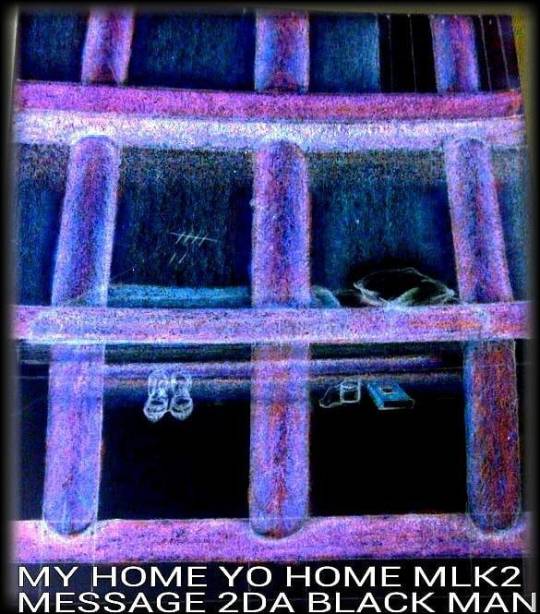
AMERICAN NEGRO: A MIGRANT'S STORY Listen to the drum beat drum beat From my West African Motherland to an island in the Caribbeanne Listen to the drum beat drum beat Listen to my heart weep heart weep To a plantation in a Southern State to Emancipation from which I could not escape Listen to the drum beat drum beat Listen to my heart weep heart weep Back to enslavement because the 13th Amendment says they can because of convict leasing just ask any historianne Listen to the drum beat drum beat Listen to my heart weep heart weep Went home to the Maker from being hung from a tree cause the Ku Klux Klan thought that’s how it ought to be Listen to the drum beat drum beat Listen to my heart weep heart weep Jim Crow a great friend of the Klan so I left the South to become a Chicagoanne Listen to the drum beat drum beat Listen to my heart weep heart weep Congress cut off funding for Wars in foreign lands created a drug called Crack from the Columbian Hinterlands Started a Drug War aimed at the Black community and locked us all up with impunity Listen to the drum beat drum beat Listen to my heart weep heart weep Now I’m a part of this new diaspora from Miami, L.A., Brooklyn to Peoria 21st Century Jim Crow. Now a penitentiary cell is my new home Back to bread and water being a full-course meal just like an 1841 so what’s the big deal THIS IS THE AMERICAN NEGROS’ MIGRANT STORY went from a plantation Hell to a Warden’s prison cell Now we’re just lonely and alone and the songs we once heard we don’t hear no moe “Brotha over there in the next cell, ‘Are you still listening for the drum beat the drum beat?’ I don’t” Oh Lord, just put my heart to sleep heart to sleep American Negro: A Migrant’s Story by Donald “C-Note” Hooker Artwork by C-Note About Artist: Donald "C-Note" Hooker is a native angeleno. He is a poet, playwright, performing artist, award winning visual artist, and the King of Prison Hip Hop. His works have either been exhibited, performed, or sold, from Alcatraz to Berlin. In 2017, Google Search listed him as both America's and the world's most prolific Prisoner-Artist. ##darealprisonart #hiphop #poet #performingartist #playwright #Love #art #artist #blackart https://www.instagram.com/p/Bsk98PXF3K0/?utm_source=ig_tumblr_share&igshid=j93vx61z2uf1
0 notes